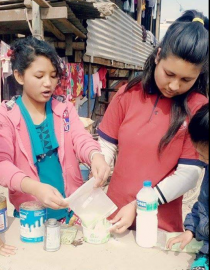Light at Night
DFA NYU Collaborates with Youth in a Kathmandu Slum to Increase Feelings of Safety in Their Community

Mixing a paint in Kathmandu that draws energy from the sun and glows at night
Inspiration can come from many sources, especially if you’re a creative person focused on human-centered design like the members of the NYU studio of Design for America (DFA).
Last year, along with their adviser, Anne-Laure Fayard, a professor in Tandon’s Department of Technology, Management and Innovation, members of DFA NYU traveled to Nepal for a research and prototyping trip connected to the Bindi Project, which they had developed as part of an OpenIDEO challenge on Women and Girls’ Safety. (The open innovation platform is run by IDEO, a well-respected global design and innovation consultancy.)
The Bindi Project, piloted in collaboration with Women for Human Rights (WHR), a Nepalese NGO, called for providing women in low-income neighborhoods with the knowledge, skills, and support they need to become leaders and catalysts for change with and in their communities.
During the first meeting with 36 women from the Tripureshwor slum in Kathmandu, it became apparent that the lack of light in their community was a major issue, causing them to feel in danger and preventing them from leaving their homes at night.
That evening, during their debriefing session, the DFA NYU team brainstormed different options to provide access to light, which was an issue that repeatedly came up during their research phase. While there were electrical poles nearby, the women could not have access to electricity because of their designation as a slum, and lanterns or flashlights did not seem to be a viable alternative because of their price.
Fayard remembered an idea posted on the OpenIDEO platform: a campaign using solar paint on posters that would glow at night. Why not do something similar, the team thought?
Besides, as Fayard knew, there is a distinction between an area being safe and its inhabitants feeling secure. “The ‘broken window theory’ suggests that the environment inspires — or does not inspire — a sense of safety,” she explained. “Carrying a flashlight down a dark alley might make you safer because you can see the dangers around you, but that doesn’t inspire a positive, secure feeling. The environment itself can do that.”
The next day they shared their idea with the women and brainstormed further. They confirmed that carrying lanterns, installing solar panels, or obtaining access to electricity were not viable options, and after asking a lot of questions, the women showed interest in exploring the solar paint solution.
Back in New York, the group continued to explore ways in which to modify the environment in the slum to make its inhabitants feel more secure, and they thought further about the idea of luminescent paint; even a faint glow emitting from the surrounding buildings might be enough to help, they realized. Paint — unlike flashlights and lanterns — had the added advantage of being difficult to steal once it was applied.

Preparing the second live prototype
Doctoral candidate Ashwin Gopi, who had been involved in the Bindi Project since its inception, did some research and discovered that mixing Europium-doped Strontium Aluminate with epoxy would create a paint that would draw energy from the sun during the day and glow at night. That discovery was only one part of the equation, however; there was also the issue of sourcing the raw materials.
He found that the cheapest and most convenient supplier of Europium-doped Strontium Aluminate (a crystalline powder with phosphorescent properties) was based in China, but the team still needed to find a source for transparent epoxy. Partners on the ground in Kathmandu (Bikash Aryal and his friends from the Tripureshwor Youth Club, along with Saru Shipalkar and Pushpar Joshi, their mentors from the Bhaktapur Youth Club), struggled to find anything suitable in local stores. Team members in New York even enlisted a Nepalese NYU Tandon student who had offered to help: he called upon his sister, who was living in Kathmandu, to begin searching as well.
Eventually, a paint store that could supposedly supply the correct epoxy was found in June 2016, but the team’s travails were far from over: they had not counted on monsoon season, and storms delayed the actual painting until October 2016. When a small section of wall could finally be painted, it was discovered that the epoxy was white, rather than transparent as Gopi had specified, resulting in a weaker-than-hoped-for glow. “It was tempting to simply give up at that point,” Gopi admitted. “That was a period that really taught us the importance of resilience.”
But those in Nepal did not give up, and transparent epoxy was ultimately found. In coordination with Fayard and Gopi, the team in Nepal chose a small sample of houses in an area that both got sunlight during the day and felt unsafe at night. They chose to paint arrows rather than cover entire walls: first, because using less of the substance would save money, and also because they felt that the arrow motif would add an element of path finding — and thus safety — to the project. (Once this was defined, they had to convince some of the inhabitants, which they did successfully.)
They are now working to scale up the project — getting advice from professional painters, gathering data on residents’ responses to the paint, and finding additional communities in which to test their idea.
“Ashwin and I are very proud of the team in Kathmandu and truly inspired by the work of those in Nepal” Fayard said. “We plan to support them as they continue evolving the idea and the process. This project is an inspiring story that shows how empathy, collaboration and ongoing prototyping can lead to improving the lives of people in our communities.”




